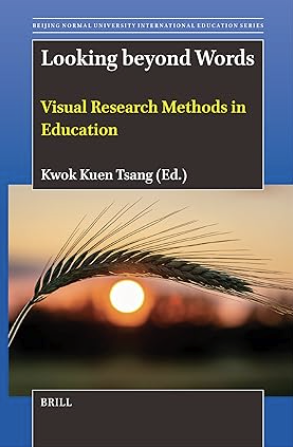Book Reviews: Research

Looking Beyond Words: Visual Research Methods in Education
Kwok Kuen Tsang, ed. 2024. Brill Publishing. [ISBN 978-90-04-70213-4. 212 pages, including index. US$49.00 (paperback).]
Index Terms—education, photovoice, qualitative analysis, visual research methods
Reviewed by Jiawei Gao, Student, University of International Business and Economics, Beijing, China.
In today’s “visually-driven world” (p. 1), consuming, producing, and recreating visual images has become a routine activity for all individuals. This visual culture has also reshaped the academic landscape, drawing researchers’ attention to visual analysis. Despite there being abundant research advocating for visual analysis of the social world, most of it comes from disciplines like anthropology and ethnography. There is a lack of research on visual applications, especially in the education field for methodological and theoretical exploration. Looking Beyond Words: Visual Research Methods in Education, edited by Kwok Kuen Tsang, fills this gap, serving as a valuable resource for educational researchers interested in visual analysis.
This book is a collection of research articles, involving methodological and theoretical explorations, and their implementations in empirical settings. The book opens with an introduction of visual culture, materials, data, and research methods. In this introduction, Tsang elaborates on the development of theories and methods of visual analysis, underlining the significant gap in research within the education field.
This volume features ten articles authored by experienced, emerging education scholars from across the globe, including Germany, New Zealand, Australia, Hong Kong, and China. Chapter 1 presents a qualitative narrative review of thirty-one articles that examine the use of photography as a research method in school-based compulsory education, focusing particularly on the reasons for employing photography and its use. Chapters 2 and 3 shift to early childhood education contexts with distinct aims: Chapter 2 highlights the significance of “visual surplus” in promoting multi-perspective interpretations of children’s learning process, while Chapter 3 analyzes three types of visual data collected through field observation, underlining the role of the visual research method in revealing the hidden curriculum. Chapters 4–6 introduce three different research methods: objective hermeneutics, classroom video analysis and photo elicitation. While Chapters 5 and 6 primarily revolve around theoretical development, implementation guidelines, and methodological significances of these approaches, Chapter 4 goes further by applying objective hermeneutics to investigate the meaning structure of an MTV website. Chapters 7–10 pay attention to the “photovoice” research method with varying emphases: Chapter 7 proposes it as a tool for critical reflection to support teachers’ professional identity development; Chapters 8 and 9 show empirical studies in the Chinese context, discussing the contribution of photovoice to teachers’ perspectives of rural education and to emancipatory learning and critical awareness, respectively; Chapter 10 tackles the methodological challenges in photovoice research, proposing a four-stage framework for data analysis.
Looking Beyond Words: Visual Research Methods in Education powerfully pinpoints the significant gap in implementation of visual analysis within education. It addresses this gap by bringing together a group of scholars to discuss various theories and methodologies, as well as to share empirical designs, representing a profound effort to integrate visual research methods into the realm of education.

